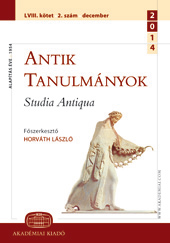Rítus múlt időben (két pausaniasi történet Achaeából)
Rite in the past tense (two story from Pausanias)
Author(s): Sámuel GáborSubject(s): Cultural history, Ancient World, Greek Literature
Published by: Akadémiai Kiadó
Keywords: Pausamias; rite; Patrae; Dionysus; Artemis;
Summary/Abstract: In the seventh book of the Periegesis Hellados Pausanias tells us two Patraean love-stories. One of them is about a priest of Dionysus Kalydonius, loving a girl not requiting his love, who asked god Dionysos for help. The end of the legend is sort of a melodrama, where we see both, the priest and the beloved girl to die. It is a simple but unusual and striking plot—in Pausanias’ own interpretation a story about the power of ardent Love. The other one, which is closely related to a rite performed at Patras every year, is more complex. It has two stages: the first half of the story is about a sacrilegious liaison of two lovers, and the punishment of Artemis on Patras, their city, for the lover’s deeds in the form of yearly human sacrifices, whereas the second half is about the Dionysian madness of a Thessalian hero called Eurypylus. The two parts of the story are interrelated through the final episode when Eurypylus finds remedy in the city of Patras at the same time when the Patraeans disengage from the yearly human sacrifice they had been forced to offer Artemis up to this day. The special way these two parts of the myth are combined in the rite allows us to interpret the myth in the light of the rite, and vice versa. In my analyses I try to pass beyond both the nineteenth-century concept that interprets Pausanian stories stemming from some Hellenistic literary sources, and the fashionable contemporary approach according to which such rites are primarily rites de passage, that results in explanations of the concrete ritual forms just in the primeval routines and not in the cultural life of the societies concerned. I try to understand these Patraean stories, cults, and myths told by Pausanias as one cultural complex where all the elements are interdependent and add something to each other.
Journal: Antik Tanulmányok
- Issue Year: 57/2013
- Issue No: 2
- Page Range: 209-221
- Page Count: 13
- Language: Hungarian
- Content File-PDF

